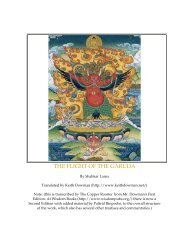Hiller - The Myth of Primitivism. Perspectives on Art - Esoteric Online
Hiller - The Myth of Primitivism. Perspectives on Art - Esoteric Online
Hiller - The Myth of Primitivism. Perspectives on Art - Esoteric Online
You also want an ePaper? Increase the reach of your titles
YUMPU automatically turns print PDFs into web optimized ePapers that Google loves.
Ethnography and the formati<strong>on</strong> <str<strong>on</strong>g>of</str<strong>on</strong>g> nati<strong>on</strong>al and cultural identities 159<br />
with the inevitable restricti<strong>on</strong>s imposed by the architecture itself, the museum guided its<br />
public through its collecti<strong>on</strong>s in a specific though not always linear narrative,<br />
encouraging implicit if not explicit associati<strong>on</strong>s (Figure 9.1). In view <str<strong>on</strong>g>of</str<strong>on</strong>g> ethnographic<br />
curators’ claims to the popular (albeit ‘scientific’) accessibility <str<strong>on</strong>g>of</str<strong>on</strong>g> the presentati<strong>on</strong> inside<br />
the building, it is significant that the external ‘shell’, in the case <str<strong>on</strong>g>of</str<strong>on</strong>g> the larger municipal<br />
and nati<strong>on</strong>al collecti<strong>on</strong>s, was the ‘temple’ type. <str<strong>on</strong>g>The</str<strong>on</strong>g> imposing and distancing<br />
c<strong>on</strong>notati<strong>on</strong>s <str<strong>on</strong>g>of</str<strong>on</strong>g> this type <str<strong>on</strong>g>of</str<strong>on</strong>g> public building were fully appreciated by many c<strong>on</strong>temporary<br />
curators and resulted in a series <str<strong>on</strong>g>of</str<strong>on</strong>g> novel architectural schemes which were designed to<br />
overcome this obstacle. 9<br />
<str<strong>on</strong>g>The</str<strong>on</strong>g> Col<strong>on</strong>ial exhibiti<strong>on</strong>s, <strong>on</strong> the other hand, were notable for precisely the absence <str<strong>on</strong>g>of</str<strong>on</strong>g><br />
such a m<strong>on</strong>olithic structure and an apparent lack <str<strong>on</strong>g>of</str<strong>on</strong>g> rigorously imposed c<strong>on</strong>trol over the<br />
viewing space (Figure 9.2). This semblance <str<strong>on</strong>g>of</str<strong>on</strong>g> endless choice and unrestricted freedom<br />
was an important factor in the effectiveness <str<strong>on</strong>g>of</str<strong>on</strong>g> these exhibiti<strong>on</strong>s in obtaining a broad<br />
basis <str<strong>on</strong>g>of</str<strong>on</strong>g> c<strong>on</strong>sent for the imperial project. Through the rhetoric <str<strong>on</strong>g>of</str<strong>on</strong>g> ‘learning through<br />
pleasure’, the exhibiti<strong>on</strong>s achieved the sort <str<strong>on</strong>g>of</str<strong>on</strong>g> popular appeal that the museums dreamed<br />
<str<strong>on</strong>g>of</str<strong>on</strong>g>. Far more successfully than the museum whose exhibits could <strong>on</strong>ly signify the<br />
col<strong>on</strong>ized subject, the exhibiti<strong>on</strong>s literally captured these potentially dangerous subjects<br />
and reproduced them in a ‘safe’ and c<strong>on</strong>tained, and yet accessible and supposedly open,<br />
envir<strong>on</strong>ment.<br />
This usually meant c<strong>on</strong>structing mock ‘villages’ stocked with items that were<br />
purportedly characteristic and representative <str<strong>on</strong>g>of</str<strong>on</strong>g> a particular culture. Often peopled by<br />
troupes <str<strong>on</strong>g>of</str<strong>on</strong>g> pr<str<strong>on</strong>g>of</str<strong>on</strong>g>essi<strong>on</strong>al performers from different African societies, Ceyl<strong>on</strong>, or other<br />
participants from Ireland and Scotland, these ‘villages’ were always favourites for press<br />
attenti<strong>on</strong>. Railway and other transport networks within the exhibiti<strong>on</strong> grounds had the<br />
effect, reinforced by the text in the guidebooks, <str<strong>on</strong>g>of</str<strong>on</strong>g> allowing the visitor metaphorically to<br />
travel from <strong>on</strong>e country to another without ever having to leave the site. 10 C<strong>on</strong>sequently,<br />
they cultivated, at <strong>on</strong>e and the same time, both a sense <str<strong>on</strong>g>of</str<strong>on</strong>g> the availability and the<br />
c<strong>on</strong>tainability <str<strong>on</strong>g>of</str<strong>on</strong>g> those societies represented. <str<strong>on</strong>g>The</str<strong>on</strong>g> ‘villages’




